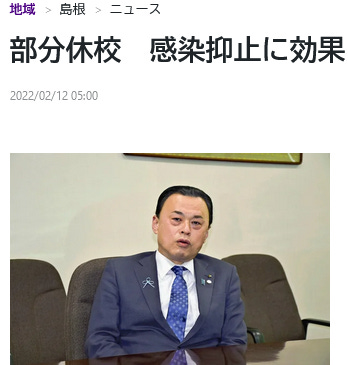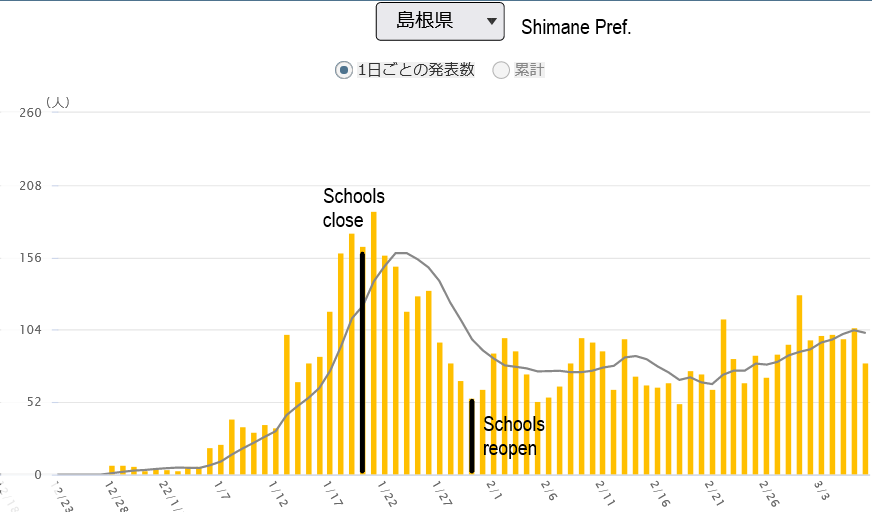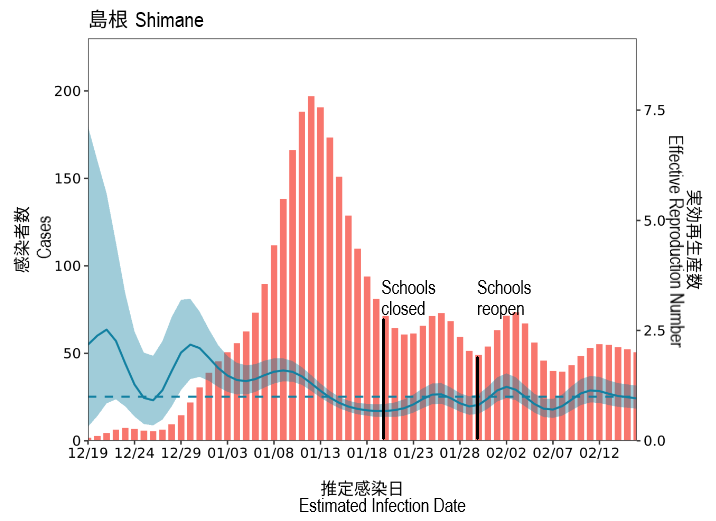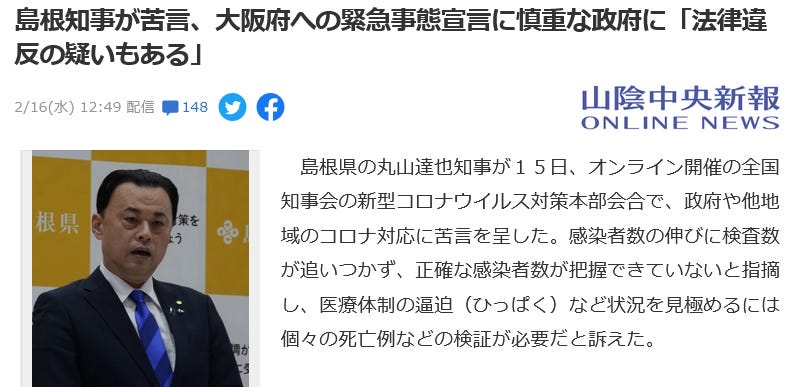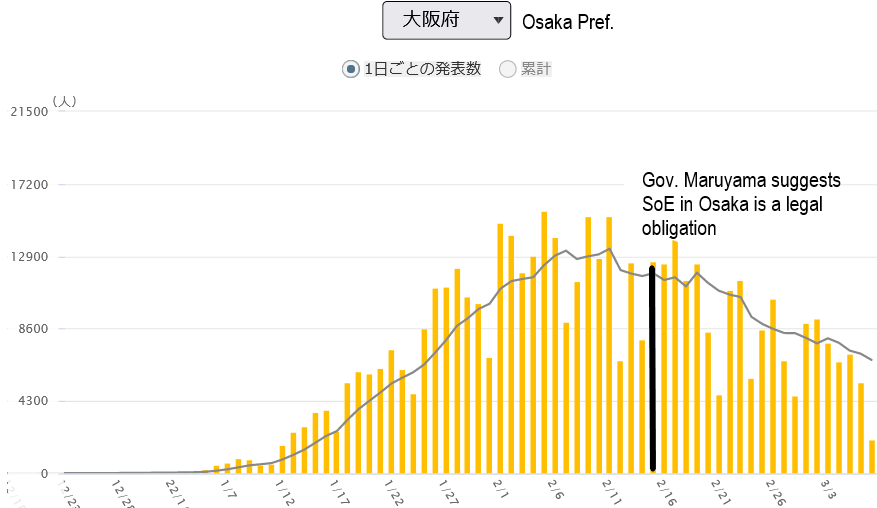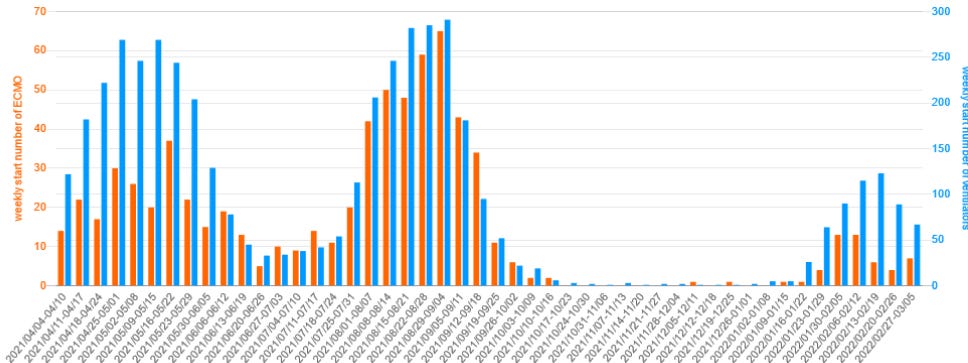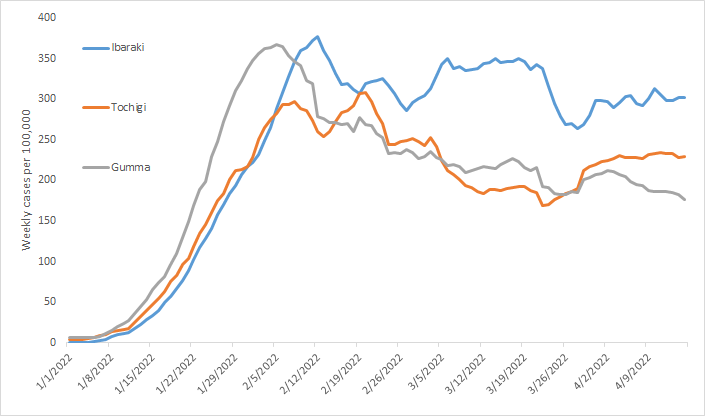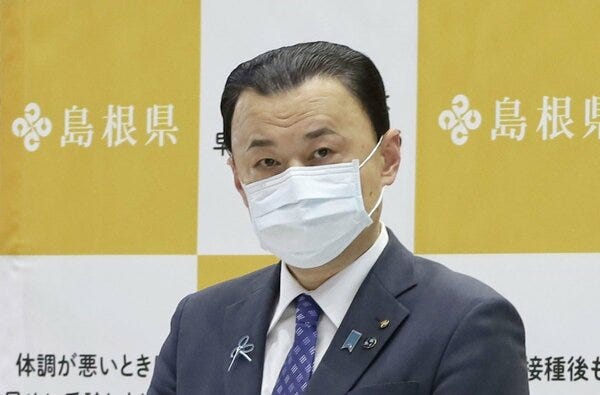Japan's most annoying governor (updated 27 April 2022)
After previously profiling Japan’s most moronic governor (Shinji Hirai of Tottori), I’d like to introduce the most annoying one, Tatusya Maruyama of neighbouring Shimane (pop 665,000). Here he is being interviewed about his decision to close schools for 10 days in four towns.
Headline: Partial school closures effectively suppress infections
Interviewer: “The Ministry of Education thinks that regional school closures should be avoided from the perspective of their negative educational and psychological effects on children. Weren’t you hesitant about taking a different response?”
Gov. Maruyama: “Even if you don’t have the national government’s seal of approval, you have to do what’s necessary. To reduce the burden on households, you should reduce the number of cases.”
Of course, the “effect” of school closures is an illusion caused by the lag between infections and reported PCR test results. Now you see it…
[Daily confirmed cases in Shimane]
…now you don’t.
[Cases by estimated infection date based on symptom onset data]
He also suggested the national government’s unwillingness to declare a state of emergency (SoE) in Osaka was possibly illegal: “Legally, when specified conditions have been met, declaring a state of emergency is an obligation. So there’s a question about the legality of the government’s response.”
Headline: Shimane Gov complains about govt caution towards SoE in Osaka: “There’s even a question about the legality”
As we can see from the graph of Osaka’s daily confirmed cases, Gov. Maruyama’s mere words were as effective at reducing cases as any of the first, second, third, and fourth SoEs.
Gov. Maruyama has also severely criticised members of the government’s panel of experts for suggesting Japan’s quasi-emergency measures are excessive considering Omicron’s low severity rate: “Even if the severity rate is 1/10, if you have 20 times as many infections, you’ll have two times the burden on the medical system.”
Headline: “They could be clever idiots”: Shimane Gov harshly criticises govt experts’ discussions
If only there were some real-world data for him to consult.
[Weekly new cases requiring ECMO (orange) or mechanical ventilation (blue) in Japan https://crisis.ecmonet.jp/]
Needless to say, Gov. Maruyama is incensed at more people suggesting Japan should treat Omicron like the flu and stop the isolation of close contacts of positive cases, calling such ideas “infection release measures”.
Headline: Shimane Gov Muruyama harshly criticises govt: “They’re spreading the idea that Omicron is the same as a cold or flu”
And to be fair, he has a point about the equivalency of Omicron and the flu: if Omicron and the flu were equally severe, Shimane Prefecture would probably have more sick people.
[https://toyokeizai.net/sp/visual/tko/covid19/en.html]
Updated 27 April 2022
I thought I’d update this post since Tatsuya has recently got his angry face in the news again since the mayor of Matsue City refused the governor’s request to close elementary schools for a week because of an outbreak of PCR positive tests.
Headline: “Do you have a magic wand like Harry Potter?” Shimane Governor harshly criticises Matsue Mayor for infection prevention measures
Gov Maruyama was characteristically flabbergasted. “As governor of Shimane, I’ve got to throw my hands up at Matsue City. Do you have a magic ward to wave and sort it out like Harry Potter?”
If anyone thinks Gov Maruyama may have a point about school closures, can you guess from this graph which of these neighboring prefectures had the majority of its elementary schools go remote for the first three weeks of February and one week in the middle of March?
If you answered Ibaraki (the blue line), congratulations! As you can see, keeping kids at home doesn’t really stop the spread. And if you’re still not convinced, see here.
But not content with hassling kids, Gov Maruyama is also telling people not to come to or go out of Shimane to visit relatives or for vacation over the Golden Week holidays.
Headline: Shimane Governor requests self-restraint against coming to and going from prefecture
He had this to say too: “In urban areas, there’s an atmosphere that people at no risk of severe disease can go out eating and drinking without a care, but people in Shimane don’t have that mentality.”
He may have a point, But the data on severe cases in Japan’s urban areas like Tokyo (pop 14 million) suggests people in Shimane would be better off changing their mentality.




